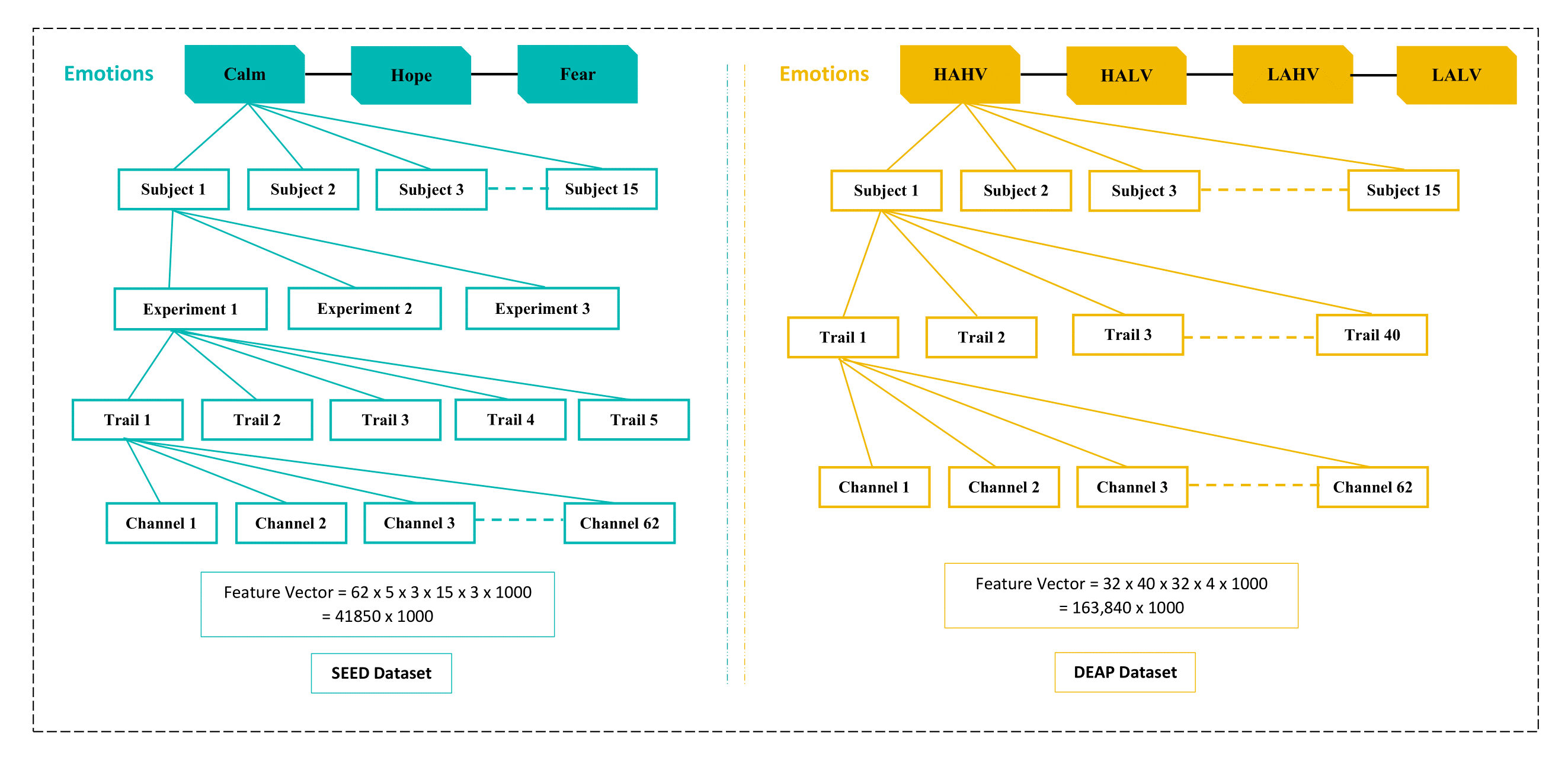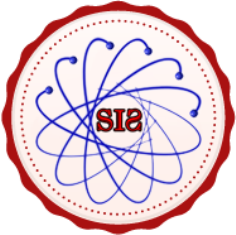DECS: A Deep Learning Approach for EEG Channel Selection in Emotion Classification
Keywords:
Bag of Deep Features, Continuous Wavelet Transform, Differential Entropy-based channel selection, Support Vector MachineAbstract
The non-stationary nature of Electroencephalogram (EEG) signals often leads to high computational complexity in emotion recognition systems. To address this, we propose a novel framework that integrates optimal channel selection with efficient feature extraction. Our method begins by converting preprocessed EEG signals into two-dimensional spectrograms using a Continuous Wavelet Transform (CWT). These spectrograms are then processed by a GoogLeNet model for deep feature extraction. A key contribution is the Differential Entropy-based Channel Selection (DECS) technique, which identifies and retains the most informative channels. To manage dimensionality, the extracted features are encoded using the Bag-of-Deep-Features (BoDF) method, which employs k-means clustering to create a visual vocabulary and represents features as histograms. Finally, these histogram features are classified using a Support Vector Machine (SVM). Evaluated on the SJTU SEED and DEAP datasets, the proposed model achieves state-of-the-art classification accuracies of 95.1% and 81.1%, respectively, demonstrating its effectiveness and efficiency.
References
Y. Liu, R. Liang, S. Xu, and X. Guo, “Structural investigations of multi-reservoir Echo State Networks for EEG-based emotion classification,” Neurocomputing, vol. 632, p. 129856, Jun. 2025, doi: 10.1016/J.NEUCOM.2025.129856.
S. Abdumalikov, J. Kim, and Y. Yoon, “Performance Analysis and Improvement of Machine Learning with Various Feature Selection Methods for EEG-Based Emotion Classification,” Appl. Sci. 2024, Vol. 14, Page 10511, vol. 14, no. 22, p. 10511, Nov. 2024, doi: 10.3390/APP142210511.
R. Gajšek, V. Štruc, and F. Mihelič, “Multi-modal emotion recognition using canonical correlations and acoustic features,” Proc. - Int. Conf. Pattern Recognit., pp. 4133–4136, 2010, doi: 10.1109/ICPR.2010.1005.
H. Chao, L. Dong, Y. Liu, and B. Lu, “Emotion Recognition from Multiband EEG Signals Using CapsNet,” Sensors 2019, Vol. 19, Page 2212, vol. 19, no. 9, p. 2212, May 2019, doi: 10.3390/S19092212.
W. Ma, Y. Zheng, T. Li, Z. Li, Y. Li, and L. Wang, “A comprehensive review of deep learning in EEG-based emotion recognition: classifications, trends, and practical implications,” PeerJ Comput. Sci., vol. 10, p. e2065, May 2024, doi: 10.7717/PEERJ-CS.2065.
P. Tzirakis, J. Zhang, and B. W. Schuller, “End-to-end speech emotion recognition using deep neural networks,” ICASSP, IEEE Int. Conf. Acoust. Speech Signal Process. - Proc., vol. 2018-April, pp. 5089–5093, Sep. 2018, doi: 10.1109/ICASSP.2018.8462677.
F. Aloise, P. Aricò, F. Schettini, S. Salinari, D. Mattia, and F. Cincotti, “Asynchronous gaze-independent event-related potential-based brain–computer interface,” Artif. Intell. Med., vol. 59, no. 2, pp. 61–69, Oct. 2013, doi: 10.1016/J.ARTMED.2013.07.006.
P. Arico, G. Borghini, G. Di Flumeri, N. Sciaraffa, and F. Babiloni, “Passive BCI beyond the lab: current trends and future directions,” Physiol. Meas., vol. 39, no. 8, p. 08TR02, Aug. 2018, doi: 10.1088/1361-6579/AAD57E.
G. Di Flumeri et al., “EEG-based Approach-Withdrawal index for the pleasantness evaluation during taste experience in realistic settings,” Proc. Annu. Int. Conf. IEEE Eng. Med. Biol. Soc. EMBS, pp. 3228–3231, Sep. 2017, doi: 10.1109/EMBC.2017.8037544.
P. Aricò et al., “Human Factors and Neurophysiological Metrics in Air Traffic Control: A Critical Review,” IEEE Rev. Biomed. Eng., vol. 10, pp. 250–263, 2017, doi: 10.1109/RBME.2017.2694142.
K. Markopoulos, C. Mavrokefalidis, K. Berberidis, and E. Daskalopoulou, “BCI-based approaches for real-time applications,” ACM Int. Conf. Proceeding Ser., Nov. 2016, doi: 10.1145/3003733.3003785.
M. A. Asghar et al., “EEG-Based Multi-Modal Emotion Recognition using Bag of Deep Features: An Optimal Feature Selection Approach,” Sensors 2019, Vol. 19, Page 5218, vol. 19, no. 23, p. 5218, Nov. 2019, doi: 10.3390/S19235218.
N. K. Al-Qazzaz, M. K. Sabir, S. Ali, S. A. Ahmad, and K. Grammer, “Effective EEG Channels for Emotion Identification over the Brain Regions using Differential Evolution Algorithm,” Proc. Annu. Int. Conf. IEEE Eng. Med. Biol. Soc. EMBS, pp. 4703–4706, Jul. 2019, doi: 10.1109/EMBC.2019.8856854.
M. A. Ozdemir, M. Degirmenci, O. Guren, and A. Akan, “EEG based emotional state estimation using 2-D deep learning technique,” TIPTEKNO 2019 - Tip Teknol. Kongresi, Oct. 2019, doi: 10.1109/TIPTEKNO.2019.8895158.
K. Y. Wang, Y. L. Ho, Y. De Huang, and W. C. Fang, “Design of Intelligent EEG System for Human Emotion Recognition with Convolutional Neural Network,” Proc. 2019 IEEE Int. Conf. Artif. Intell. Circuits Syst. AICAS 2019, pp. 142–145, Mar. 2019, doi: 10.1109/AICAS.2019.8771581.
K. Guo, H. Yu, R. Chai, H. Nguyen, and S. W. Su, “A Hybrid Physiological Approach of Emotional Reaction Detection Using Combined FCM and SVM Classifier,” Annu. Int. Conf. IEEE Eng. Med. Biol. Soc. IEEE Eng. Med. Biol. Soc. Annu. Int. Conf., vol. 2019, pp. 7088–7091, Jul. 2019, doi: 10.1109/EMBC.2019.8857698.
P. Santhiya and S. Chitrakala, “A Survey on Emotion Recognition from EEG Signals: Approaches, Techniques Challenges,” Proc. - Int. Conf. Vis. Towar. Emerg. Trends Commun. Networking, ViTECoN 2019, Mar. 2019, doi: 10.1109/VITECON.2019.8899671.
H. Ullah, M. Uzair, A. Mahmood, M. Ullah, S. D. Khan, and F. A. Cheikh, “Internal Emotion Classification Using EEG Signal with Sparse Discriminative Ensemble,” IEEE Access, vol. 7, pp. 40144–40153, 2019, doi: 10.1109/ACCESS.2019.2904400.
R. Yan, N. Lu, Y. Yan, X. Niu, and J. Wu, “A Fine-grained Hemispheric Asymmetry Network for accurate and interpretable EEG-based emotion classification,” Neural Networks, vol. 184, p. 107127, Apr. 2025, doi: 10.1016/J.NEUNET.2025.107127.
C. G. Coogan and B. He, “Brain-Computer Interface Control in a Virtual Reality Environment and Applications for the Internet of Things,” IEEE Access, vol. 6, pp. 10840–10849, Feb. 2018, doi: 10.1109/ACCESS.2018.2809453.
L. Song and J. Epps, “Classifying EEG for Brain-Computer Interface: Learning Optimal Filters for Dynamical System Features,” Comput. Intell. Neurosci., vol. 2007, no. 1, p. 057180, Jan. 2007, doi: 10.1155/2007/57180.
A. Mert and A. Akan, “Emotion recognition from EEG signals by using multivariate empirical mode decomposition,” Pattern Anal. Appl., vol. 21, no. 1, pp. 81–89, Feb. 2018, doi: 10.1007/S10044-016-0567-6/METRICS.
C. N. Anagnostopoulos, T. Iliou, and I. Giannoukos, “Features and classifiers for emotion recognition from speech: a survey from 2000 to 2011,” Artif. Intell. Rev., vol. 43, no. 2, pp. 155–177, Feb. 2015, doi: 10.1007/S10462-012-9368-5/METRICS.
M. T. Sadiq et al., “Motor imagery EEG signals classification based on mode amplitude and frequency components using empirical wavelet transform,” IEEE Access, vol. 7, pp. 127678–127692, 2019, doi: 10.1109/ACCESS.2019.2939623.
J. Kevric and A. Subasi, “Comparison of signal decomposition methods in classification of EEG signals for motor-imagery BCI system,” Biomed. Signal Process. Control, vol. 31, pp. 398–406, Jan. 2017, doi: 10.1016/J.BSPC.2016.09.007.
M. A. Asghar, Fawad, M. J. Khan, Y. Amin, and A. Akram, “EEG-based Emotion Recognition for Multi Channel Fast Empirical Mode Decomposition using VGG-16,” 2020 Int. Conf. Eng. Emerg. Technol. ICEET 2020, Feb. 2020, doi: 10.1109/ICEET48479.2020.9048217.
W. L. Zheng and B. L. Lu, “Investigating Critical Frequency Bands and Channels for EEG-Based Emotion Recognition with Deep Neural Networks,” IEEE Trans. Auton. Ment. Dev., vol. 7, no. 3, pp. 162–175, Sep. 2015, doi: 10.1109/TAMD.2015.2431497.
T. Zhang, W. Zheng, Z. Cui, Y. Zong, and Y. Li, “Spatial-Temporal Recurrent Neural Network for Emotion Recognition,” IEEE Trans. Cybern., vol. 49, no. 3, pp. 939–947, Mar. 2019, doi: 10.1109/TCYB.2017.2788081.
X. Li, D. Song, P. Zhang, Y. Zhang, Y. Hou, and B. Hu, “Exploring EEG features in cross-subject emotion recognition,” Front. Neurosci., vol. 12, no. MAR, p. 294333, Mar. 2018, doi: 10.3389/FNINS.2018.00162/BIBTEX.
R. W. Homan, J. Herman, and P. Purdy, “Cerebral location of international 10–20 system electrode placement,” Electroencephalogr. Clin. Neurophysiol., vol. 66, no. 4, pp. 376–382, Apr. 1987, doi: 10.1016/0013-4694(87)90206-9.
A. K. Vuong, J. Zhang, R. L. Gibson, and W. W. Sager, “Application of the two-dimensional continuous wavelet transforms to imaging of the Shatsky Rise plateau using marine seismic data,” Spec. Pap. Geol. Soc. Am., vol. 511, pp. 127–146, 2015, doi: 10.1130/2015.2511(07).
V. Gupta, M. D. Chopda, and R. B. Pachori, “Cross-Subject Emotion Recognition Using Flexible Analytic Wavelet Transform from EEG Signals,” IEEE Sens. J., vol. 19, no. 6, pp. 2266–2274, Mar. 2019, doi: 10.1109/JSEN.2018.2883497.
B. Nakisa, M. N. Rastgoo, D. Tjondronegoro, and V. Chandran, “Evolutionary computation algorithms for feature selection of EEG-based emotion recognition using mobile sensors,” Expert Syst. Appl., vol. 93, pp. 143–155, Mar. 2018, doi: 10.1016/J.ESWA.2017.09.062.
C. Szegedy et al., “Going deeper with convolutions,” Proc. IEEE Comput. Soc. Conf. Comput. Vis. Pattern Recognit., vol. 07-12-June-2015, pp. 1–9, Oct. 2015, doi: 10.1109/CVPR.2015.7298594.
C. Szegedy, V. Vanhoucke, S. Ioffe, J. Shlens, and Z. Wojna, “Rethinking the Inception Architecture for Computer Vision,” Proc. IEEE Comput. Soc. Conf. Comput. Vis. Pattern Recognit., vol. 2016-December, pp. 2818–2826, Dec. 2016, doi: 10.1109/CVPR.2016.308.
Y. Qu, R. Li, A. Deng, C. Shang, and Q. Shen, “Non-unique decision differential entropy-based feature selection,” Neurocomputing, vol. 393, pp. 187–193, Jun. 2020, doi: 10.1016/J.NEUCOM.2018.10.112.
S. O’Hara and B. A. Draper, “Introduction to the Bag of Features Paradigm for Image Classification and Retrieval,” Jan. 2011, Accessed: Oct. 06, 2025. [Online]. Available: https://arxiv.org/pdf/1101.3354
L. Elazary and L. Itti, “Interesting objects are visually salient,” J. Vis., vol. 8, no. 3, pp. 3–3, Mar. 2008, doi: 10.1167/8.3.3.
M. Ester, H.-P. Kriegel, J. Sander, and X. Xu, “A Density-Based Algorithm for Discovering Clusters in Large Spatial Databases with Noise,” 1996, Accessed: Oct. 06, 2025. [Online]. Available: www.aaai.org

Downloads
Published
How to Cite
Issue
Section
License
Copyright (c) 2025 50sea

This work is licensed under a Creative Commons Attribution 4.0 International License.




















